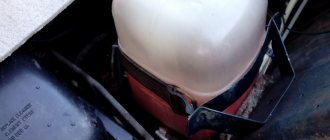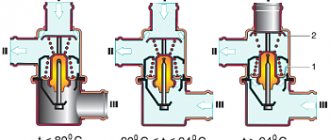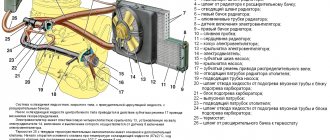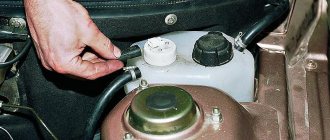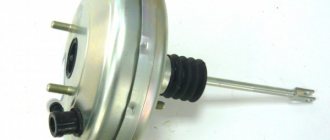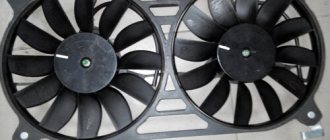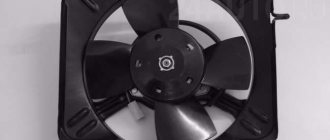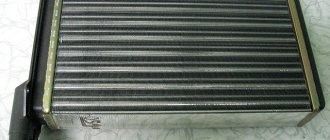The VAZ-2109 has a forced circulation cooling system. What does it mean? It's simple, when engine parts heat up, the cooling unit takes away their heat.
The cooling unit is a closed, sealed system that circulates liquid. It has valves (inlet and outlet) that maintain pressure when the car is moving.
The cooling system circuit consists of the following kit:
- expansion tank. It, together with the valves, ensures that pressure is maintained;
- a pump that pumps liquid. It moves in large and small circles;
- a fan that increases air flow into the car body;
- sensors that transmit all information to the electronic control unit;
- radiator. In the VAZ-2109, it doesn’t matter whether you have a carburetor or an injector, because they have the same design;
- thermostat. They automate all the work of the OS;
- pipes and clamps. They perform the function of supplying fluid.
How does the VAZ-2109 cooling system work?
Where does the work of the CO begin? From the expansion tank, which is the main element in the entire system. It contains all the liquid, as well as its excess (boiled antifreeze, which is transferred to a special tank). After it has cooled down, it immediately continues its work. The volume of CO in a VAZ-2109 car is 7.8 liters. The tank has valves that maintain pressure. When the pressure increases, the exhaust valve begins to operate, and when the pressure decreases, the inlet valve begins to operate.
The tank is translucent, so checking the fluid level will not bring you any inconvenience.
Special hoses connect the expansion tank and the thermostat.
The stages that the liquid goes through are:
- A sensor is installed in the cylinder block that monitors the temperature. These readings can be seen on the dashboard.
- When the engine starts running, liquid from the jacket flows into the radiator, where it receives heat, or into the thermostat to warm up the engine.
- After this, the cooling liquid passes into the injector. It circulates using pipes and clamps.
- The VAZ-2109 uses a centrifugal pump. The radiator does not have a filler hole; an expansion tank is used for this. It contains a sensor that turns on the fan. If you want to drain the fluid, unscrew the drain plugs on the radiator, tank and cylinder block.
If you understand the cooling system, you can repair your car yourself.
Refueling procedure
After installing all the removed parts in place, you can begin the procedure for filling the cooling system. To properly fill antifreeze into a VAZ 2109, you will need almost 8 liters of liquid. First of all, old antifreeze is poured in. In this case, it is better to use gauze again. If the quality of the drained antifreeze does not inspire confidence, it is better to completely replace it with a new one.
Refueling occurs through the opening of the expansion tank, but all the liquid will not fit at once; you will have to warm up the engine so that it swallows the already filled volume and makes room for the remainder. It is important to remember that refueling is done to the minimum mark, because antifreeze expands when heated and can break through the pipes, tank or lid.
Malfunctions in the system
In a domestic car VAZ-2109, you can independently identify problems in the cooling system.
For example, system overheating occurs if:
- lack of coolant - check, add if necessary;
- the pump belt is torn or worn - replace it;
- the radiator is clogged with dirt - flush or replace;
- The fan may be broken.
There are also a number of other malfunctions:
- Coolant leak. Hoses may be damaged or parts may crack. If fluid is lost, the system is overfilled.
- Corrosion can occur if the water is contaminated or the antifreeze solution is not formulated correctly.
- Air locks (warm up the engine properly, then let the car sit, remove the hose and start the engine again - this will help expel the air).
How much antifreeze should be poured into a VAZ-2109
Take two 5 liter eggplants. Since the volume is 7.8 liters, first drain the old fluid and fill in a new one in a volume of 6 liters. After warming up the engine, then the thermostat will open and you can add the remaining amount of fluid. The main thing is to pour in an even and continuous stream so that there are no air pockets.
Please advise how much antifreeze should be poured into the VAZ 2109?
- VAZ engine overheating – 16 answers
- Why does the engine on a VAZ 2108 get hot? – 4 answers
- Why doesn't the engine warm up, VAZ? – 4 answers
- The engine cools down to 70 degrees when driving - 4 answers
- The fan on the VAZ 2108 constantly works - 3 answers
If we are talking about volume, then 8.7 liters (including the tank). To better understand what, where, and why to pour, see the cooling system diagram, where:
1 – expansion tank plug; 2 – expansion tank; 3 – radiator supply hose; 4 – hose from the radiator to the expansion tank; 5 – radiator outlet hose; 6 – left radiator tank; 7 – aluminum radiator tubes; 8 – sensor for turning on the electric fan; 9 – right radiator tank; 10 – drain plug; 11 – radiator core; 12 – electric fan casing; 13 – electric fan impeller; 14 – electric motor; 15 – pump gear pulley; 16 – pump impeller; 17 – camshaft drive toothed belt; 18 – heater radiator outlet pipe; 19 – pump supply tube; 20 – hose for draining fluid from the heating of the inlet pipe to the carburetor heating block; 21 – carburetor heating block; 22 – exhaust pipe; 23 – heater supply pipe; 24 – hose for draining fluid from the heating of the inlet pipe and the carburetor heating unit; 25 – thermostat; 26 – hose from the expansion tank to the thermostat.
How much antifreeze is in the VAZ 2109 cooling system
The cooling system is designed to ensure stable operation of the engine, which generates a lot of power and constantly rises in temperature.
Coolant is a specific alcohol-based composition with additives that acts as a coolant.
Coolant refill
What to choose?
Today, when replacing OZ on domestic cars, they often talk about antifreeze. But in addition to antifreeze, antifreeze is actively used for more modern cars.
For the VAZ 2109 cooling system, it is quite possible to use antifreeze rather than antifreeze.
Coolant type
Peculiarities
- All coolants. antifreeze, and antifreeze. this is a kind developed back in Soviet times as an alternative to foreign antifreeze;
- Antifreeze. just the name of a type of antifreeze, more adapted to the specific operation of cars in the conditions of our country (then the USSR);
- The price is more affordable compared to other refrigerants;
- More widely used among domestic car owners
- The variety of antifreeze in the world is enormous;
- The difference between them lies in the base, color, composition and other parameters;
- Antifreezes use special additives in their composition that ensure efficient operation of the cooling system and extend the life of the refrigerant itself;
- Antifreeze is more expensive, which is the most common reason for choosing antifreeze
What are the consequences of an untimely change?
If replacement deadlines are not met, the car owner will face the following problems:
- Antifreeze will not be able to perform its intended functions. This will result in the car's heating system not working as efficiently at low temperatures. In some cases, the stove does not function at all.
- Due to the appearance of sediment in the pipes and radiator of the car, the circulation of the working fluid will be disrupted. This will cause excessive heating of the power unit. Prolonged use of a machine with an overheated engine can lead to failure of the unit.
Drain old coolant
- To work you need a pit or overpass. In a garage this is not a problem.
- Start the procedure with a cold engine only. Do not add new coolant if you just turned off the engine a few minutes ago. Otherwise, there is a risk of cracks in the cylinder block.
- Remove the negative battery terminal.
- Place a prepared capacity of about 10 liters under the car.
- Remove the cap from the CO expansion tank.
- Using a socket or a 13mm wrench, unscrew the drain plug from the cylinder block.
- Hold the plug so that the coolant pressure does not release it anywhere. It's not worth losing such an element.
- When all the liquid has come out, screw the lid on.
- Drain the coolant from the radiator by unscrewing the plastic cap. The liquid will flow into the prepared container.
- Tighten the drain cap by hand. No tool needed here.
WHEN IS IT NECESSARY TO REPLACE ANTISELF?
- This issue should not be overlooked in any case. Because if the antifreeze is unsuitable, the engine will not cool properly.
- If the engine does not cool to the required degree, then there may be problems with the cooling system (partial failure) and spare parts will have to be replaced.
- In the worst case, the engine may boil - this does not bode well for you and your car.
- Thus, the engine must be well cooled, especially in winter. In winter, problems most often arise with the cooling system.
- In view of this fact, it is better to prepare in advance. That is, in the fall it is necessary to change the antifreeze.
- It is advisable to change antifreeze every autumn closer to winter. You should also replace parts of your car's engine cooling system that are damaged or close to failure.
Note! It is especially recommended to change antifreeze every year on older cars, since there is a greater likelihood of rust contaminating the radiator and other parts of the cooling system.
- Also, if rusty antifreeze is detected in the car’s cooling system, it is extremely necessary to flush the system. This will be mentioned below.
WHAT TO CHOOSE?
Many car owners often wonder about the choice of coolant - antifreeze or antifreeze: which is better? Let's try to figure out what's what without going into deep truths.
- In fact, all coolants are and are called antifreeze. And antifreeze is no exception to the rule.
- In fact, antifreeze is just the name of one of the types of antifreeze developed in our area, for our area and for our cars.
- In terms of its performance and characteristics, antifreeze is in many ways inferior to other antifreezes.
- The price of antifreeze is much lower than other coolants.
- Antifreeze is more common among domestically produced cars.
- There are very, very many antifreezes in the world. They differ in composition, base, color, and so on.
- Various antifreezes include various special additives that help better maintain the car's cooling system and at the same time increase the service life of the antifreeze itself.
- The cost of antifreeze is higher than antifreeze, and it is quite widespread.
Summarize. Antifreeze or other antifreeze?
- Antifreeze is undoubtedly better in quality.
- BUT antifreeze is much more practical for several reasons.
- Antifreeze was SPECIALLY designed for our climate and our cars.
- Antifreeze is available in almost every domestic car that passes you.
- And this can sometimes save (in case of a breakdown on the road).
- There is enough antifreeze for the car to function normally and the cooling system to work as expected.
It is more practical and cheaper (which is very important) to use antifreeze.
WE CHANGE THE ANTIFICE OURSELVES
How to replace antifreeze on a VAZ 2109 yourself? The answer to this question is discussed below and until the end of the article. Be careful.
Important! Before replacing antifreeze, make sure that all parts of your car's cooling system are in working order and do not require repair. If this is not the case, then you should first repair the damaged parts or replace them, and then (or simultaneously) change the coolant.
Tools and accessories
What will be needed to ensure that the replacement of antifreeze on a VAZ 2109 occurs without wasting extra time and effort?
Prepare the following in advance:
- Antifreeze or antifreeze - 8 liters
- Container for drainage (to fit under the car)
- 13mm socket, extension and ratchet
- Or a 13mm wrench (open-end or socket)
- Key for 8
- Key for 10
- Screwdriver
- Watering can
Have you prepared? You can start working.
Draining antifreeze
Now we begin to drain the antifreeze. Remember, car repairs are best done in an inspection pit or overpass.
It’s still good on a lift, but this phenomenon is rarely seen in a garage:
Advice! Do not forget - you should replace the antifreeze on a cold engine. Under no circumstances should you fill in cold new antifreeze if you have just driven the car into the garage and it has not yet cooled down sufficiently. This threatens a crack in the cylinder block.
- So, our VAZ 2109 is in the pit and ready to drain the antifreeze.
- Before you start draining it, take a 10mm key and be sure to unscrew the negative terminal of the battery so that when you drain the antifreeze, a short circuit does not occur, and you don’t have to repair it later with an electrician.
- Place a previously prepared antifreeze container under the car, which should be about 10 liters in volume.
- Remove the cap on the expansion tank of the cooling system.
- Take a 13mm socket with the rest of the accessories or a 13mm wrench and unscrew the drain plug from the cylinder block.
Attention! Hold the plug so that the pressure of the coolant does not blow it away and you do not lose it.
- After all the antifreeze has drained from there, you can screw the plug back on.
- Next, you need to drain the antifreeze from the radiator of the cooling system.
- To do this, unscrew the plastic plug, and the liquid also flows into the antifreeze container located under the car.
- Screw the plug back - it can be screwed in and out simply with your own hands (no tools required).
The first stage of replacing the antifreeze in the VAZ 2109 has been completed - we have drained the antifreeze. Go ahead!
Flushing the cooling system
Washing is done in some cases. One of them is rusty drained antifreeze. This means that the system is contaminated, and clean new antifreeze will not remain so for long - it will quickly become unusable.
- Flushing is done using two means: a special flush for the cooling system or ordinary water (preferably distilled, but, in extreme cases, regular running water can also be used).
- The flushing fluid is poured into the cooling system through the neck of the vehicle's cooling system expansion tank.
- Then the engine starts and the car runs at low speeds for ten minutes.
- Next, you should turn off the engine and repeat the process of draining the coolant, which has already been described above.
- The system flushing procedure is repeated until the drained water is more or less clear in color or according to the instructions for special flushing of the cooling system.
fill
To fill with new antifreeze, you don’t have to do anything complicated. You only need a special watering can. Many containers in which antifreeze is sold are not particularly convenient for pouring directly from them. Use a funnel to avoid spilling coolant.
It is extremely important to know how much tosol is in the cooling system. Coolant for the VAZ 2109 requires 7.8 liters. Therefore, antifreeze should be purchased in 8-liter containers.
- Take a watering can and insert it into the neck of the expansion tank. This way you won't waste precious grams of antifreeze.
- Make sure all drain plugs are securely tightened. Otherwise, the coolant will simply pour onto the floor and he will have to buy new coolant.
- Begin gradually pouring in new antifreeze.
- Stop periodically for 1-2 minutes to allow the liquid to distribute through the system.
- When filling the system, pour the coolant into the middle of the expansion tank level.
- Then the most important thing. get rid of the air received from the cooling system.
- Air accumulates in the upper pipe. To remove it, you just need to squeeze the top tube a few times. Squeeze until you feel there is liquid inside.
- Remove air from the cooling system. To do this, unscrew the clamp that holds the return hose to the CO expansion tank (return) using a screwdriver or a size 8 wrench.
- Now close the throttle with your finger, which is put on the return channel, so that the air cannot go out.
- Then you need to blow up the expansion tank. Just imagine trying to inflate a tank like a balloon.
- In this way you create pressure and the refrigerant will begin to flow out of the expansion tank into the CO, and excess air will flow through the return.
- As soon as the antifreeze begins to flow out, the procedure can be stopped.
- Return the backflow to the seat, tighten the clamp.
- connect the negative terminal of the battery, close the cap of the expansion tank and check the quality of the work done.
It is not recommended to start active operation of the vehicle without checking.
Briefly about replacement
The process of replacing antifreeze on VAZ 2109 engines is carried out either once every three years, or once every 60 thousand km, or (advisable) when carrying out repair work on cooling system units. The operation route looks like this:
- remove the ignition module (on injection models);
- drain the used antifreeze;
- Having disconnected the coolant supply hose to the throttle assembly (injector) or to the carburetor, fill in a new mixture through the expansion tank;
- start the engine for 1-2 minutes;
- check and, if necessary, add antifreeze;
- start and warm up the engine to the fan operating temperature (105-107 degrees);
- turn off the engine, inspect the system for leaks, and if necessary, add antifreeze to the medium level.
examination
Checking for OJ replacement is easy, but the importance of this procedure should not be underestimated.
- Start the engine and let it run for a few minutes at medium speed;
- When the new antifreeze is heated by the return flow, the coolant will flow into the expansion tank;
- If the liquid spills out, you did everything right;
- Check the operation of the thermostat, temperature sensors, cooling fan;
- When the engine temperature rises, the thermostat opens when it is in good working order. Feel the bottom of the thermostat. If it's warm, everything works great;
- Wait until the fan turns on automatically, cool the system, and turn it off. Again, this behavior indicates the sensor and fan are working.
As you can see, it is not at all difficult to change the antifreeze (or antifreeze) on a VAZ 2109 yourself. Therefore, there is no need to pay someone to do a job that takes literally an hour of your time and does not require complex dismantling procedures.
Step-by-step instruction
The coolant replacement process begins with draining the used composition. To do this, you must wait until the engine cools down; the pressure in the system must drop to safe values. Next, you need to place a container of sufficient volume under the radiator and unscrew the drain plug, having first removed the cap at the top of the radiator. To remove all remnants of old antifreeze from the system, you should also drain it from the cylinder block (if this is provided for by the design of the car and there is a corresponding neck on the BC).
Next, you need to screw the drain plug back and pour the required amount of coolant through the filler neck on the radiator. In some cars, it is possible to fill directly into the expansion tank. The required amount of antifreeze can be found by reading the technical documentation for the vehicle.
During the first time after replacement, you need to periodically check the coolant level in the expansion tank. It may decrease as the liquid gradually spreads through all channels of the working circuit, filling their entire volume.
